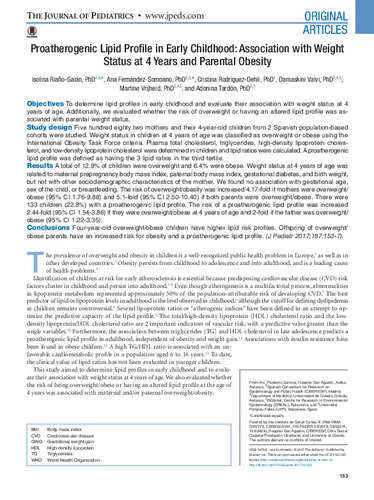Proatherogenic lipid profile in early childhood: association with weight status at 4 years and parental obesity
Fecha de publicación:
Versión del editor:
Citación:
Descripción física:
Resumen:
OBJECTIVES: To determine lipid profiles in early childhood and evaluate their association with weight status at 4 years of age. Additionally, we evaluated whether the risk of overweight or having an altered lipid profile was associated with parental weight status. STUDY DESIGN: Five hundred eighty two mothers and their 4-year-old children from 2 Spanish population-based cohorts were studied. Weight status in children at 4 years of age was classified as overweight or obese using the International Obesity Task Force criteria. Plasma total cholesterol, triglycerides, high-density lipoprotein cholesterol, and low-density lipoprotein cholesterol were determined in children and lipid ratios were calculated. A proatherogenic lipid profile was defined as having the 3 lipid ratios in the third tertile. RESULTS: A total of 12.9% of children were overweight and 6.4% were obese. Weight status at 4 years of age was related to maternal prepregnancy body mass index, paternal body mass index, gestational diabetes, and birth weight, but not with other sociodemographic characteristics of the mother. We found no association with gestational age, sex of the child, or breastfeeding. The risk of overweight/obesity was increased 4.17-fold if mothers were overweight/obese (95% CI 1.76-9.88) and 5.1-fold (95% CI 2.50-10.40) if both parents were overweight/obese. There were 133 children (22.8%) with a proatherogenic lipid profile. The risk of a proatherogenic lipid profile was increased 2.44-fold (95% CI 1.54-3.86) if they were overweight/obese at 4 years of age and 2-fold if the father was overweight/obese (95% CI 1.22-3.35). CONCLUSIONS: Four-year-old overweight/obese children have higher lipid risk profiles. Offspring of overweight/obese parents have an increased risk for obesity and a proatherogenic lipid profile
OBJECTIVES: To determine lipid profiles in early childhood and evaluate their association with weight status at 4 years of age. Additionally, we evaluated whether the risk of overweight or having an altered lipid profile was associated with parental weight status. STUDY DESIGN: Five hundred eighty two mothers and their 4-year-old children from 2 Spanish population-based cohorts were studied. Weight status in children at 4 years of age was classified as overweight or obese using the International Obesity Task Force criteria. Plasma total cholesterol, triglycerides, high-density lipoprotein cholesterol, and low-density lipoprotein cholesterol were determined in children and lipid ratios were calculated. A proatherogenic lipid profile was defined as having the 3 lipid ratios in the third tertile. RESULTS: A total of 12.9% of children were overweight and 6.4% were obese. Weight status at 4 years of age was related to maternal prepregnancy body mass index, paternal body mass index, gestational diabetes, and birth weight, but not with other sociodemographic characteristics of the mother. We found no association with gestational age, sex of the child, or breastfeeding. The risk of overweight/obesity was increased 4.17-fold if mothers were overweight/obese (95% CI 1.76-9.88) and 5.1-fold (95% CI 2.50-10.40) if both parents were overweight/obese. There were 133 children (22.8%) with a proatherogenic lipid profile. The risk of a proatherogenic lipid profile was increased 2.44-fold (95% CI 1.54-3.86) if they were overweight/obese at 4 years of age and 2-fold if the father was overweight/obese (95% CI 1.22-3.35). CONCLUSIONS: Four-year-old overweight/obese children have higher lipid risk profiles. Offspring of overweight/obese parents have an increased risk for obesity and a proatherogenic lipid profile
Patrocinado por:
Funded by the Instituto de Salud Carlos III (Red INMA G03/176, CB06/02/0041, FIS-FEDER 04/2018, 09/02311, 13/02429), Hospital San Agustín, CIBERESP, Obra Social Cajastur/Fundación Liberbank, and University of Oviedo. The authors declare no conflicts of interest.
Colecciones
- Artículos [37548]
- Investigaciones y Documentos OpenAIRE [8420]
- Medicina [989]
Ficheros en el ítem





